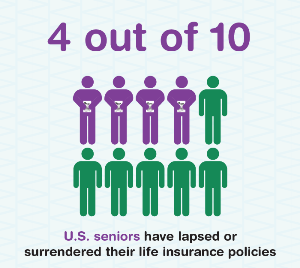Nothing spells financial disaster like letting your life insurance lapse. OK, perhaps that’s an exaggeration, but allowing a life insurance policy to lapse is one of the worst financial decisions you can make without first checking out all of your options. Americans pay hundreds of millions of dollars into life insurance premiums every year, yet four out of ten senior’s lapse or surrender their policies before they receive any payout. The insurance industry loves it when that happens – they win the bet and that’s how they make money. However, there a new option available that the insurance companies do not want you to know about – but I’m here to share it with you.
Why Does a Policy Lapse?
 Life insurance lapses for a number of reasons: Typically, the coverage becomes unaffordable or the policyholder’s life situation changes and the insured believe he or she no longer needs the coverage. Life insurance is frequently purchased to protect the financial future of the policyholder’s family. Parents purchase life insurance so that if one parent dies, then lost income is replaced by the insurance company and the surviving spouse and children will have money to pay bills, fund college tuition and have a financial cushion. Changes in life situations often alter the equation too. If parents’ divorce or one spouse dies after children are grown and out of the house, then life insurance may appear to no longer be needed and the policyholder may decide to let the policy lapse.
Life insurance lapses for a number of reasons: Typically, the coverage becomes unaffordable or the policyholder’s life situation changes and the insured believe he or she no longer needs the coverage. Life insurance is frequently purchased to protect the financial future of the policyholder’s family. Parents purchase life insurance so that if one parent dies, then lost income is replaced by the insurance company and the surviving spouse and children will have money to pay bills, fund college tuition and have a financial cushion. Changes in life situations often alter the equation too. If parents’ divorce or one spouse dies after children are grown and out of the house, then life insurance may appear to no longer be needed and the policyholder may decide to let the policy lapse.
Lapse Rates Drive Profits
Insurance companies make a tremendous amount of money from lapsed policies, after individuals pay premiums for years and then never collect a death benefit. Individuals should do everything in their power to keep their policies in force. Knowing this inside information levels the playing filed. You can now sell your policy for a huge profit.
Keep Policies in Force
Policyholders now have a number of options if faced with the question of whether or not to let a policy lapse. For term policies that are nearing the end of the term, policyholders often have the option to convert the policy to a whole life policy. Particularly if you want to remain insured, then a conversion is an excellent option because the policy will be underwritten based on your health status when you purchased the original policy
For whole life policies, premium amounts can rise quickly and become burdensome to the policyholder. Before letting the policy lapse or surrendering it, consult with me to ensure that you are paying the least amount of premium possible with your policy. Using some of the cash value to pay premiums may be an option.
Consider All Options
If the premiums payments are expensive and the insured is very late in life, another option is to have the beneficiaries take over and pay the premiums. Having some idea of how long you may have to live, is critical to understanding all of your options. For example, if the insured is in failing health, paying the premium for a few years may be an excellent investment. If the policy pays out the full death benefit when you pass, and the premiums are affordable, it might make financial sense for beneficiaries to help front the cost.
Consider Selling It!
Policyholders can sell their life insurance policy for cash and stop making premium payments. The actual value of your policy varies depending on the life expectancy of the policyholder at the time of sale, and the ongoing premiums necessary to keep the policy in force. Selling it will always be less than the full value of the policy, but much more than the amount a policyholder would receive if he or she let the policy lapse or surrendered it to the insurance company. Click here to get your customized life expectancy. Remember, information is power!
For years, Americans’ have viewed life insurance as a mere financial backstop, but by exploring options to keep policies in force, additional value can be attained for policyholders and their beneficiaries.
If you have a policy and are interested, contact me today for a free appraisal.
